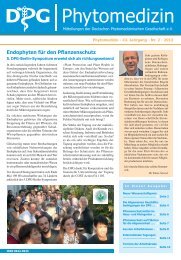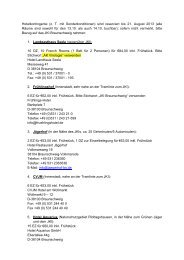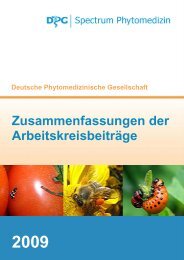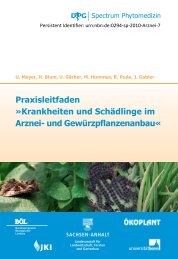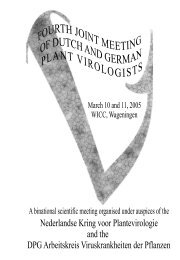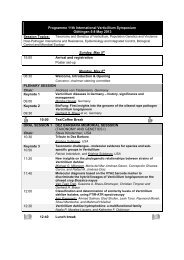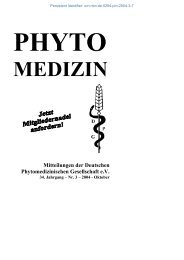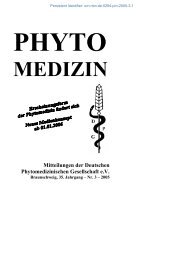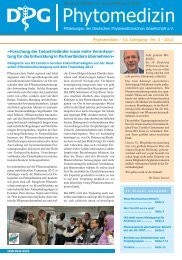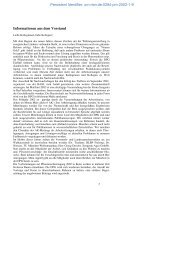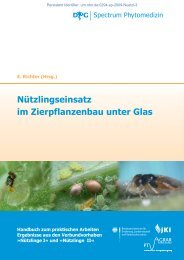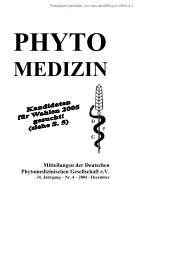Zusammenfassungen der Arbeitskreisbeiträge - Die DPG
Zusammenfassungen der Arbeitskreisbeiträge - Die DPG
Zusammenfassungen der Arbeitskreisbeiträge - Die DPG
Erfolgreiche ePaper selbst erstellen
Machen Sie aus Ihren PDF Publikationen ein blätterbares Flipbook mit unserer einzigartigen Google optimierten e-Paper Software.
habitat preferences. Parentage and kinship analysis of the offspring to analyze individual<br />
foraging decisions is in progress.<br />
THE CHALCID WASP SCHIZONOTUS SIEBOLDI (PTEROMALIDAE) AS A PUPAL<br />
PARASITOID OF THE RED POPLAR LEAF BEETLE, CHRYSOMELA POPULI L.<br />
(COLEOPTERA: CHRYSOMELIDAE), IN SHORT ROTATION COPPICE (SRC)<br />
Richard Georgi, Michael Müller<br />
Technische Universität Dresden, Professur für Forstschutz, Pienner Str. 8, 01737 Tharandt<br />
Email: richard.georgi@tu-dresden.de<br />
Chrysomela populi is the main pest species in SRC (short rotation coppice) with poplar in<br />
Germany. Mass development of this pest species can result in loss of increment and loss of<br />
cuttings and coppice shoots. The larger the area of SRC and the greater their linking the<br />
higher is the probability for damage. Therefore, this species has become more and more an<br />
important economic factor when managing SRC. There is relatively little knowledge about<br />
natural enemies of C. populi. The chalid wasp Schizonotus sieboldi has been proven to be a<br />
very important pupal parasitoid on all three investigated study sites in Brandenburg and<br />
Saxony. The parasitation rate ranged from 35% to 73% (50% on average) in a total of six<br />
investigations. Imagines of S. sieboldi deposit eggs on the abdominal side of the pupae thorax.<br />
The development of the six larval stages and the pupal stage takes place un<strong>der</strong> the wing pads<br />
and the thoracic appendages of C. populi. In average11.5 adults of S. sieboldi (maximum 29)<br />
emerged per pupae. The more pteromalid wasps emerged per pupae the higher is the male<br />
percentage. Female Imagines are significantly larger (2.61 mm on average) than male<br />
Imagines (2.19 mm on average). With respect to the introduction of guidelines for Integrated<br />
Pest Management (IPM) in 2014, this natural enemy is a potential species to prevent mass<br />
outbreaks of C. populi. Further research is needed in terms of promoting S. sieboldi by<br />
improving of habitat structures.<br />
PARASITOIDS OF THE MULBERRY SCALE PSEUDAULACASPIS PENTAGONA<br />
H. Raule<strong>der</strong>, R. Albert<br />
Agricultural Technology Centre Augustenberg (LTZ), Stuttgart<br />
Email: reinhard.albert@ltz.bwl.de<br />
The mulberry scale originates from East Asia and was imported to Italy at the end of the<br />
nineteenth century. The first detection in Germany was in the 60s in Bavaria. The scale has<br />
been active in Baden-Wuerttemberg since 1985. Since about 10 years heavy infestation by the<br />
scale insect with massive damage has occurred in commercial horticulture and since about 5<br />
years also in private gardens. The foliage of infested trees often becomes sparse and yellow.<br />
Heavy infestations can lead to stunted growth, premature fruit drop and may result in the<br />
death of the host plant.The trunk, branches and twigs of heavily infested plants may look as if<br />
whitewashed. From the United States of America 121 host plants are known. These include<br />
among others peaches, currants, raspberries, maple, bluebeard, pear, blue bells, oak, ash, lilac,<br />
kiwi, lime, mulberry, black locust, catalpa and walnut. The mulberry scale has 2 generations<br />
per year in the north and four generations in the south. The adult female is a yellowish-white<br />
to reddish-orange unsegmented (sac-like) insect about 1 mm in diameter. The females are<br />
covered by an oval to circular scale, which is normally white with a brown centre and 2 - 2.5<br />
mm in diameter. The adult male is a tiny aphid-like yellow insect, less than 1 mm long, with<br />
only two-wings (wing span is 1.4 mm) but four eyes and a long genital stylus at the end. The<br />
scale of immature males is snowy white and 1.5 mm long. The 100-150 eggs are laid by the<br />
��



